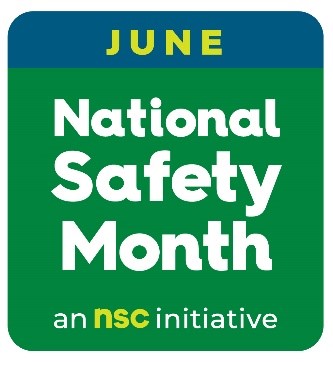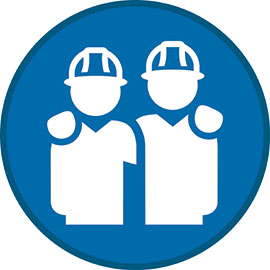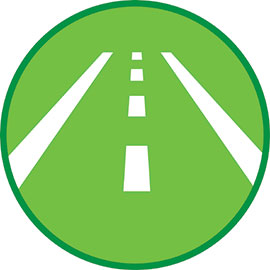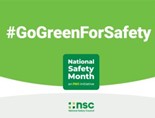National Safety Month 2024
Posted on by Each June, we bring a little extra attention to safety issues by highlighting National Safety Month®. For each week of the month, the National Safety Council (NSC) identifies a theme to focus on. This blog highlights select research and prevention efforts from the National Institute for Occupational Safety and Health (NIOSH) and NSC in this year’s focus areas of safety engagement; roadway safety; risk reduction; and slips, trips and falls.
Each June, we bring a little extra attention to safety issues by highlighting National Safety Month®. For each week of the month, the National Safety Council (NSC) identifies a theme to focus on. This blog highlights select research and prevention efforts from the National Institute for Occupational Safety and Health (NIOSH) and NSC in this year’s focus areas of safety engagement; roadway safety; risk reduction; and slips, trips and falls.
Please download and share the free safety materials from NSC including a poster, social media kit, animated graphics, 5-minute safety talks, games, articles and more – plus NSC members get additional exclusive resources. Visit the NIOSH website, eNews, blog, and social media accounts to stay safe this month and all year long.
 Week 1: Safety Engagement
Week 1: Safety Engagement
NIOSH
Both employers and employees must be engaged in safety. Working together, employers and employees can develop policies and procedures to identify, monitor, mitigate, and eliminate work-related hazards. The NIOSH Total Worker Health® workbook, Fundamentals of Total Worker Health Approaches: Essential Elements for Advancing Worker Safety, Health, and Well-Being can help workplaces:
- Provide a baseline of where an organization is on the path to worker well-being.
- Identify initial steps to improve workforce safety, health, and well-being.
- Measure an organization’s progress.
The Small Business Handbook provides small business employers with workplace safety and health information. The handbook summarizes the benefits of an effective safety and health program, provides self-inspection checklists for employers to identify workplace hazards, and reviews key workplace safety and health resources for small businesses.
NIOSH provides multiple trainings, tools, and activities to encourage employee and employer engagement in safety.
| Toolbox Talks | Stand-Downs |
| Trainings | Tools
|
NSC
When it comes to safety engagement, communication is key at all levels of an organization. Safety+Health® magazine, the flagship publication of the National Safety Council, provides helpful articles to address this important topic including:
- Harness Team Spirit to Energize Safety
- Difficult Conversations: Simple Steps to Make Them Easier
- The Power of Influence
The magazine also includes a My Story section as well as an On the Safe Side podcast series. The Council’s Safety is Personal video series shares the stories of leaders including what sparked their passion for safety, and how they live out the mission of saving lives in their workplaces every day.
Part of communicating the importance of safety is also knowing and sharing the statistics and research – the why people should care about safety. The Council’s Injury Facts® website is a wealth of information. Learn more by attending a free June 5 webinar Injury Facts: Data You Can Count On. Also, check out white papers from the NSC research team.
Taking part in activities and training are also essential to building engagement around safety. The Council encourages all workers to take the SafeAtWork pledge to show their commitment to safety. NSC offers a variety of training opportunities and events, including a new free eLearning course on Naloxone for Suspected Opioid Overdose. The more touchpoints we have with workers in all positions, the greater impact can be made in improving safety engagement.
 Week 2: Roadway Safety
Week 2: Roadway Safety
NIOSH
Motor vehicle crashes are the leading cause of work-related deaths in the United States and the 1st or 2nd leading cause of death in every major industry group.[1] The NIOSH Center for Motor Vehicle Safety conducts research and develops strategies to prevent work-related motor vehicle crashes and resulting injuries. Driver fatigue is a major workplace safety risk. The good news: a fatigue risk management system can help employers and workers reduce the risks of driver fatigue. Learn more about preventing driver fatigue on the Driver Fatigue on the Job website.
Forty-four percent of the occupational fatalities at road construction sites involved a worker struck-by a vehicle in a work zone.[2] Struck-by injuries are the leading cause of nonfatal injuries and second most common cause of fatalities among construction workers. From 2011 to 2022, 1,462 fatal occupational injuries occurred at road construction sites.[2] The 2024 National Safety Stand-Down to Prevent Struck-by Incidents highlighted the use of Internal Traffic Control Plans to help protect workers in roadway work zones. Motor vehicle-related incidents are also a leading cause of line-of-duty deaths for law enforcement officers in the United States.[3] In the last 10 years, on average, one officer per week has been killed on our nation’s roads.[3] These deaths and injuries are preventable. The NIOSH Law Enforcement Motor Vehicle Safety website offers resources and prevention strategies for all motor vehicle-related incidents including the Officer Road Code Toolkit.
NSC
NSC estimates 44,450 people died in motor vehicle crashes in 2023. With crashes being the leading cause of workplace death, the choices we make behind the wheel can improve roadway safety for us all. NSC encourages drivers to share the road responsibly by following these safety tips:
- Prepare before you go: Vehicle owners should check the oil, put air in the tires, and check for and repair open recalls to make sure their vehicles are safe for driving.
- Buckle up: Lack of seat belt use is a top cause of fatalities in crashes – buckle up, while also making sure you have appropriate car seats installed correctly.
- Designate a sober driver or arrange alternate transportation: Alcohol is only one cause of impaired driving – drugs, including opioids, cannabis and some over-the-counter medicines, can cause drowsiness, alter visual functions, and affect mental judgment and motor skills.
- Slow down: Speeding is a factor in more than a quarter of all traffic fatalities – drive the speed limit or below it if conditions dictate.
- Drive distraction-free: Thousands have died in car crashes involving cell phone use – put your phones away and #JustDrive.
- Look before you lock: Pediatric vehicular heatstroke is still the leading cause of non-crash motor vehicle-related fatality for children – always check your back seat for children or animals when you reach your destination, especially as approximately 25% of these deaths have occurred at the parent or caregiver’s place of work.
- Demand safer roads and safer speeds: Join the Road to Zero Coalition to learn about the Safe System approach on road safety.
Some employers may not be aware they have a fleet and need to follow the proper safety protocols. Unfortunately, not all fleet drivers are well-trained. Any worker who drives for work should be considered a fleet driver. Check out this webinar on the Top Three Things to Know When Managing a Fleet.
 Week 3 Risk Reduction
Week 3 Risk Reduction
NIOSH
 Reducing risk for workplace injury, illness and death is at the heart of NIOSH research and prevention efforts. A guiding principle is the hierarchy of controls, a way of determining which actions will best control exposures. The hierarchy of controls has five levels of actions to reduce or remove hazards with the most effective actions at the top of the pyramid. Using this hierarchy can lower worker exposures and reduce risk of illness or injury.
Reducing risk for workplace injury, illness and death is at the heart of NIOSH research and prevention efforts. A guiding principle is the hierarchy of controls, a way of determining which actions will best control exposures. The hierarchy of controls has five levels of actions to reduce or remove hazards with the most effective actions at the top of the pyramid. Using this hierarchy can lower worker exposures and reduce risk of illness or injury.
One of the best ways to prevent and control occupational injuries, illnesses, and fatalities is to “design out” or minimize hazards and risks. NIOSH leads a national initiative called Prevention through Design (PtD) whose purpose is to promote this concept and highlight its importance in all business decisions.
Exposure assessment plays a central role in risk management. NIOSH’s Exposure Assessment Program provides national and international leadership in the development and use of effective exposure assessment strategies and tools to prevent work-related illness and injury.
NSC
According to Injury Facts, in 2022, preventable work deaths totaled 4,695, and workplace medically consulted injuries totaled 4.53 million underscoring the importance of risk reduction. Tried and true injury prevention approaches like hazard recognition, job safety analysis and risk assessment are crucial to curbing workplace injuries and deaths.
Further, understanding the value of workplace safety and health is too often an exercise in waiting until an incident – or even a tragedy – occurs. Yet the value of safety is an increasingly multi-dimensional concept due to changing trends and dynamics well beyond physical risk. Check out the Council’s research on the New Value of Safety: From ESG to the Whole Person, which highlights three organizational concepts that generate a broad value and drive a holistic approach to safety management for highly embedded and emerging risks, including:
- Human and Organizational Performance (HOP)
- Total Worker Health®, developed by the National Institute for Occupational Safety and Health, is a comprehensive approach to worker safety, health and well-being, including addressing such topics as:
- Optimizing work design and improving working conditions
- Safeguarding and advancing the mental health of workers
- Preventing injury and fatality
- Addressing psychological safety
- Environment, Social and Governance (ESG), which covers several initiatives shaping modern safety excellence
The Council also offers several programs and initiatives addressing top occupation safety risks, including:
Check out these programs for free resources and research to help reduce risk in your organization.
 Week 4: Slips, Trips and Falls
Week 4: Slips, Trips and Falls
NIOSH
Falls are a hazard found in most work sectors. NIOSH has many fall prevention resources on its website including the ladder safety app, the mast climbing work platform inspection tool, and the mining Infographic: Don’t Slip Up! In 2022, falls from elevation represented approximately 81% of all fatal and 20% of all nonfatal slips, trips, and falls for all industry workers.[4] [5] Many of these falls occurred in the construction industry. In fact, construction workers made up nearly half (49%) of all fatal occupational slips, trips, and falls.[5] Since 2013, construction workers have suffered approximately 300 fatal and 20,000 nonfatal fall-related injuries per year.[6] The National Safety Stand-Down, part of the National Campaign to Prevent Falls in Construction, raises awareness that falls among construction workers are preventable. Read more on the blog.
The highest numbers of nonfatal fall injuries are in the health services and the wholesale and retail sectors. NIOSH research found that providing highly-rated slip-resistant shoes to food service workers led to a 67% reduction in workers compensation claims for slip injuries. Download the infographic available in English and Spanish. Slips, trips, and falls are also the most common cause of injury for workers in elementary and secondary schools. Visit the NIOSH falls website to learn how to keep workers safe.
NSC
Slips, trips and falls are a leading cause of workplace injury and death, and although a persistent challenge, they must remain top of mind. NSC provides statistics on workplace falls both to a lower level and on the same level as well as older adult falls to help show the scope of the problem. The Council also provides a Falls from Heights Toolkit, which provides best practices, planning tools, fact sheets, posters and more.
The Council’s Safety+Health magazine shares a variety of articles addressing this topic including:
- 7 Tips for Safe Use of Ladders
- 5 Facts for Safe Use of Aerial Lifts
- Reducing Slips, Trips and Falls
- Think You Know Ladder Safety? Quiz
The Work to Zero initiative at NSC believes safety technology can play an important role in preventing falls. Check out technologies for addressing the hazardous situation of Work at Height.
 These are only a few examples of how we can prevent injury, illness, and death at work and beyond. Join us in promoting safety this June and share with us how you plan to celebrate in the comment section below. Show Your Safety Pride! Choose a day or week to showcase your safety pride with the NSC Go Green for Safety campaign. Encourage your team to wear green – the universal color of safety – and hold up the printable Go Green for Safety sign. Capture photos and videos to share in your communications and on social media using the hashtags #GoGreenforSafety and #NSM. Send your best pictures to feedback@nsc.org and you just might be included on an NSC social post.
These are only a few examples of how we can prevent injury, illness, and death at work and beyond. Join us in promoting safety this June and share with us how you plan to celebrate in the comment section below. Show Your Safety Pride! Choose a day or week to showcase your safety pride with the NSC Go Green for Safety campaign. Encourage your team to wear green – the universal color of safety – and hold up the printable Go Green for Safety sign. Capture photos and videos to share in your communications and on social media using the hashtags #GoGreenforSafety and #NSM. Send your best pictures to feedback@nsc.org and you just might be included on an NSC social post.
John Howard, MD, is the Director of the National Institute for Occupational Safety and Health.
Lorraine M. Martin is the President & CEO of the National Safety Council.
This is also posted on the National Safety Council blog.
References
[1] Bureau of Labor Statistics, 2018
[2] Bureau of Labor Statistics (BLS) [2024]. Census of Fatal Occupational Injuries (2011 Forward) Database. https://www.bls.gov/iif/data.htm.
[3] National Law Enforcement Officers Memorial Fund [2021]. Causes of law enforcement deaths
[4] Bureau of Labor Statistics (2023). News Release National Census of Fatal Occupational Injuries in 2022. USDL-23-2615. December 19, 2023. Available from: https://www.bls.gov/news.release/pdf/cfoi.pdf.
[5] Bureau of Labor Statistics (2023). Number of nonfatal occupational injuries and illnesses involving days away from work, restricted activity, or job transfer (DART), days away from work (DAFW), and days of restricted work activity, or job transfer (DJTR) by event or exposure leading to injury or illness and industry sector, private industry, 2021-2022 (TABLE R64). November 8, 2023. Available from: https://www.bls.gov/iif/nonfatal-injuries-and-illnesses-tables/case-and-demographic-characteristics-table-r64-2021-2022.xlsx
[6] CPWR (2024). Data Bulletin: Fatal and Nonfatal Falls in the US Construction Industry. The Center for Construction Research and Training. Silver Spring, MD. March 2024. https://www.cpwr.com/wp-content/uploads/DataBulletin-March2024.pdf.
Posted on by

